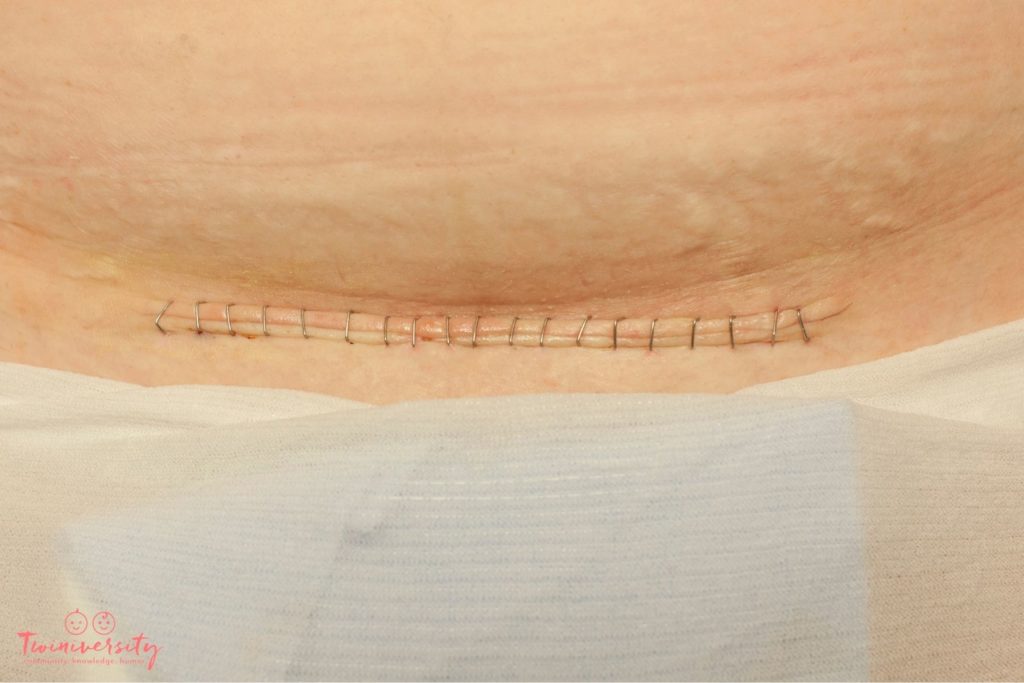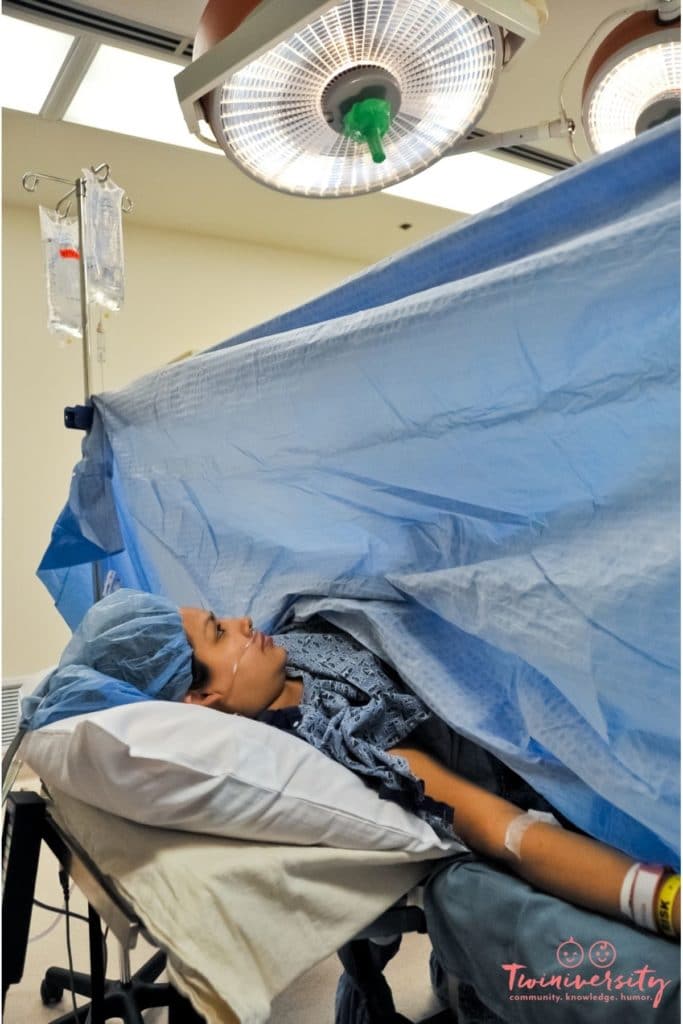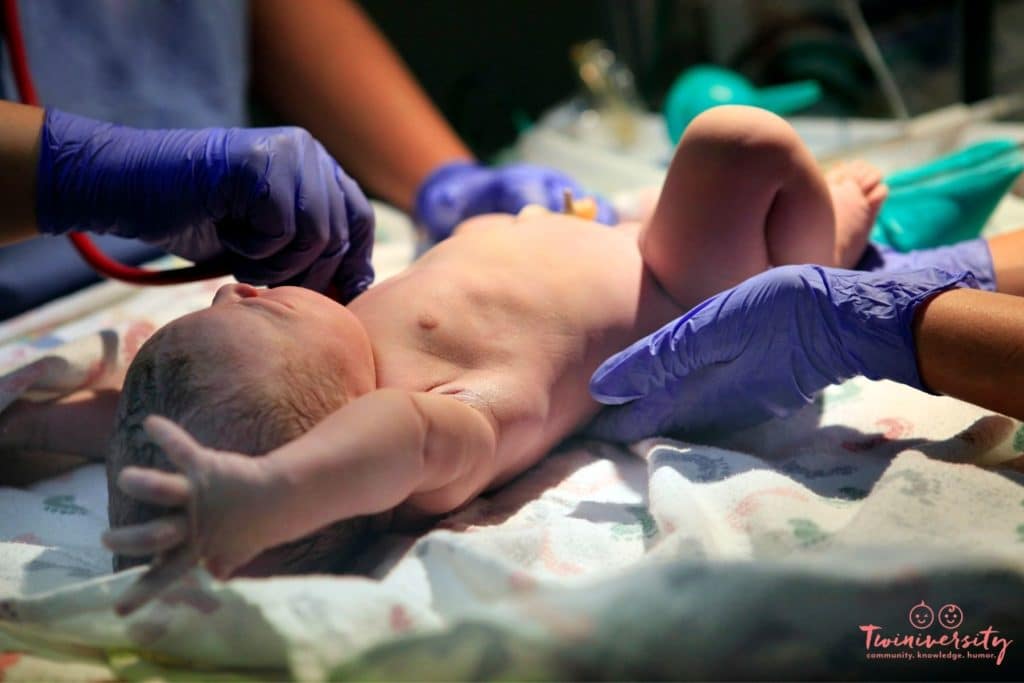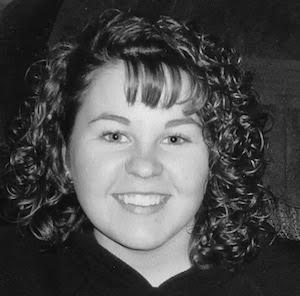Last updated on July 22nd, 2024 at 07:11 pm
I gave birth to my twins via emergency C-section. Hearing the word “C-section” terrified me. I didn’t want to worry about incisions, infections, and limitations. My 4-year-old was never going to forgive me for not being able to pick her up for 6 to 8 weeks! I may have been a bit too dramatic. If I had to do it again, I might just have had an elective C-section had I known the C-section breakdown.
Roughly 10,000 babies are born every day in the United States. About a third of them are born via C-section. Some C-sections happen on the spur of the moment and some are planned ahead of time. No matter how you get to a C-section, it’s always best to know what to expect.

Let’s breakdown a C-section play-by-play:
C-Section Breakdown: Prepping the the Night Before
One of the most important aspects we thought of for this C-section breakdown is preparation the night before if your C-section is scheduled. Although C-section births are common, it is still surgery. So, like any other operation, your doctor will give you instructions to follow the night before surgery.
These instructions typically include:
- Fasting. No food or drink for 6 to 8 hours before surgery (fasting before surgery varies from hospital to hospital).
- Shower with a special soap. The night or morning before you come in for your C-section they might ask you to shower or bathe with a bar of antiseptic antimicrobial soap to reduce the risk of infection following your C-section. You should not wear creams and lotions should not on the day of surgery.
- Don’t shave. Razors can create small nicks in the skin, which can promote infection after delivery. If you need trimming, a nurse will do this just before you go into the operating room.

Need some baby safety training? Take the Twiniversity Complete Baby Safety course, offered on-demand. Includes video modules on infant, toddler, and child CPR, first aid, and common medical ailments, plus car seat installation and safety and childproofing your home. Click here to learn more!
Other Things You’ll Need to Do Before Delivery Day
Be sure to have your bags packed and in the car. Remember to bring the car seat(s). the hospital will not allow you to leave without a properly installed car seat for the baby.
If you are overly concerned that you will not be able to sleep, talk to your doctor who can prescribe a prescription sleep aid for the evening prior to your surgery. Your doctor may prescribe other medications to take before the surgery as well.
Since you will be scheduling your C-section, try to get the earliest appointment available. You will arrive at the hospital 2 hours before your C-section, and it’s always a good idea to get in and done before the hospital is running behind. One perk of having a planned C-section is that you will be able to choose the birth date.

Arriving at the Hospital for Your C-Section
When you arrive, you will fill out all hospital admission and doctor’s release forms. Since a C-section requires written permission before it can happen, you’ll need to sign a consent form to do the procedure. Read the form carefully and ask questions if anything is unclear.
Next, you’ll go to a room in the maternity ward once you’re admitted. While you’re waiting, a nurse will start an intravenous (IV) line in your arm or hand, allowing you to receive medication or fluids when needed.
The surgical site needs to be prepped before the procedure. You may need to have your hair removed if the incision site is obstructed. Once trimmed, the skin will be cleaned with an antiseptic solution to reduce possible infection.
Your spouse or partner will also be prepped. They will need to wear scrubs or a special suit that will cover their clothing, shoe covers, shower cap, and facial mask. This is all for your protection during surgery.
You are now ready for the operation room (OR).

What to Expect in the OR During a C-Section
You will be wheeled into the OR on a hospital bed and then transferred to the operating table.
The anesthesiologist will now administer your anesthesia via an epidural or a spinal block. Both of these will numb you from the waist down, so you won’t feel any pain. You can also expect to have a catheter put into place to keep your bladder empty during the procedure.
The anesthesiologist will continuously watch your heart rate, blood pressure, breathing, and blood oxygen level during the procedure, so you’ll also be hooked up to a monitor or two.
Just before starting, your doctor will place a curtain over your chest area so you won’t be able to see the surgery as it happens.
Then it’s time to get the baby (or babies) out!

A Breakdown of What’s Happening Behind the Blue Curtain
Now let’s give you a C-section breakdown for all things happening during your surgery. First, your C-section begins with an incision (cut). Your doctor will make one cut (horizontally or vertically) in your lower abdomen, just above the pubic area, then another one in your uterus. You won’t feel either of them thanks to the anesthesia. Next, they cut the the amniotic sac and then lift out the baby or babies. You may feel the doctors pushing or pulling on your middle section as they work to remove your baby from your uterus, but it will not feel pain. Boom, baby is born!
Cord Blood Banking
Cord blood banking is the process of collecting stem cells from the umbilical cord and freezing them for future use.
Once the baby is out, the doctor will cut and clamp the umbilical cord. If you are thinking about cord blood banking, now is the time for collection. Your doctor or another hospital staffer will draw the blood from the umbilical cord. Then, they send the cord blood to the storing facility of your choice. Afterward, they’ll process it and freeze it.
To learn more about cord blood banking, click here.
Ultimately, if you decide you want to collect your baby’s cord blood, you should tell your doctor and delivery team know as soon as you can, before you deliver. And have your cord blood collection kit before delivery day!
To start the process, you can set up your account on CBR’s website, or call to speak with an Educator at 888.271.3889.
Plus, don’t forget to mention the code DUO2 for a twins discount!

Need some twin parent friends? Get the support you need with a Twiniversity Membership. Benefits include a monthly twin parent club meeting on Zoom, access to a private Facebook group just for twin parents, and a video library of twin parenting lessons. Visit Twiniversity.com/membership to join today!
Finishing the C-Section Surgery
To close out our C-section breakdown, let’s talk about what happens after your surgery. The final steps are to remove the placenta and stitch you up. Your doctor will use dissolvable stitches on the uterus and staples or stitches to close your abdominal incision.
You will receive IV antibiotics (to minimize infection risk) and oxytocin (to control bleeding and help contract the uterus). Your doctor will continue to check your blood pressure, pulse, rate of breathing, and amount of bleeding.
What Happens After the Baby Is Out
If you don’t hear your baby cry right away, don’t panic. During a vaginal birth, the excess mucus squeezes out of the baby’s respiratory tract while coming through the birth canal. So, some extra suctioning may be needed to clear your baby’s lungs if you’re having a C-section. Once delivered, doctors will place your baby on the warmer and assess him or her to make sure they don’t have trouble breathing.

Depending on how the birth goes, you might not get to see and hold your baby immediately. After you are in recovery or in your hospital room, you will be able to snuggle your little one(s) as long as you want!

Worried about breastfeeding twins? What To Do When You’re Breastfeeding Two is an on-demand online breastfeeding twins class made just for YOU! This course was created by Twiniversity in partnership with Judy Teibloom-Mishkin, IBCLC. Click here to learn more…
Breaking down What to Expect in Recovery After Your C-Section
You can expect to spend two to four hours in recovery. When you’re in the recovery room, nurses will check your blood pressure, heartbeat, and breathing regularly.
The recovery room is also a great place to start nursing. Odds are you will still be under anesthesia, so it shouldn’t hurt much at all. If breastfeeding is your plan, it is best to put your baby to the breast as soon as possible. Studies show that the more time that passes before getting the baby to the breast, the more difficult breastfeeding is.
If you are unable to nurse within the first hour after birth, you should begin pumping with a hospital-grade breast pump. Continue to nurse as often as possible and pump between feedings as well. You can also speak with a lactation consultant, if you need more help.
Although you will only stay in the hospital for two to four days after a C-section birth, full recovery can take weeks. Be sure to take care of yourself while also caring for your baby. Avoid lifting heavy objects, monitor your pain, and walk gently for exercise. Remember that everybody heals and recovers at different rates so it’s important to talk to your doctor about how you feel. And it is OK if you need more time.

Twiniversity Staff Writer










